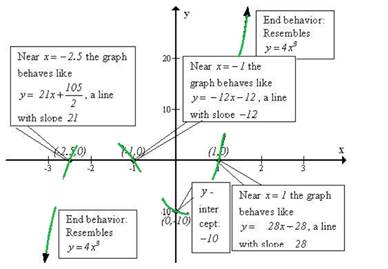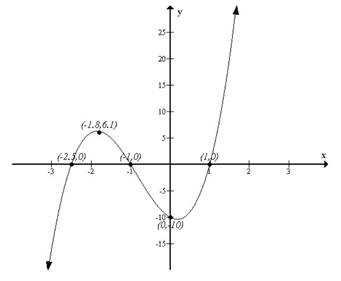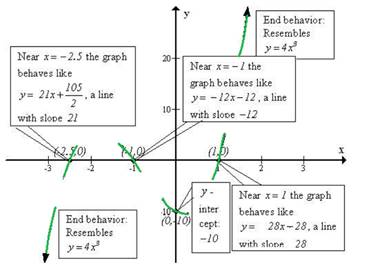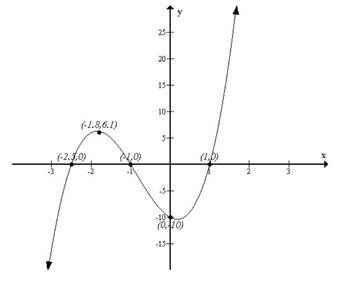
Concept explainers
To analyze: the given polynomial function
Answer to Problem 100AYU
Figure 1(a)

Figure 1(b)

Explanation of Solution
Given:
Calculation:
Let us consider
This polynomial function can be factored as
Step1: determine the end behavior of the graph of the function
Expand the polynomial to write it in the form
In view of this, consider
The polynomial function f is of degree 3. The graph of f behaves like
Step2: find the x-and y -intercepts of the graph of the function
The product of factors is zero if and only if any one of the factors is zero.
So,
Step3: to determine the zeros of the function and their multiplicityto graph the function such that the behavior of the function at the intercepts can be observed.
The root
The zero
The root
So, the function crosses x-axis three times.
Step4: Determine the maximum number of turning points on the graph of the function.
While the polynomial function is of degree 3 (step1), the graph of the function will have at most
Step5: determine the behavior of the graph of f near each x-intercept
Near the x-intercept are
The behavior of f near
This is a straight line having the slope 21.
The behavior of f near
This is a straight line having the negative slope
The behavior of f near 1 is
This is a straight line having the slope 28.
Step 6: Put all the information from Steps 1 through 5 together to obtain the graph of f Figure 1 (a) illustrates the information obtained from Steps 1 through 5. Evaluatef at
Figure 1(a)

Figure 1(b)

Conclusion:
Therefore, the given polynomial function is analyzed.
Chapter 4 Solutions
Precalculus
Additional Math Textbook Solutions
Calculus: Early Transcendentals (2nd Edition)
University Calculus: Early Transcendentals (4th Edition)
College Algebra (7th Edition)
Thinking Mathematically (6th Edition)
Calculus for Business, Economics, Life Sciences, and Social Sciences (14th Edition)
- HW: The frame shown in the figure is pinned at A and C. Use moment distribution method, with and without modifications, to draw NFD, SFD, and BMD. B I I 40 kN/m A 3 m 4 marrow_forwardLet the region R be the area enclosed by the function f(x)= = 3x² and g(x) = 4x. If the region R is the base of a solid such that each cross section perpendicular to the x-axis is an isosceles right triangle with a leg in the region R, find the volume of the solid. You may use a calculator and round to the nearest thousandth. y 11 10 9 00 8 7 9 5 4 3 2 1 -1 -1 x 1 2arrow_forwardLet the region R be the area enclosed by the function f(x) = ex — 1, the horizontal line y = -4 and the vertical lines x = 0 and x = 3. Find the volume of the solid generated when the region R is revolved about the line y = -4. You may use a calculator and round to the nearest thousandth. 20 15 10 5 y I I I | I + -1.5 -1 -0.5 0.5 1 1.5 2 2.5 3 -5 I -10 -15 I + I I T I I + -20 I + -25 I I I -30 I 3.5 4 xarrow_forward
 Calculus: Early TranscendentalsCalculusISBN:9781285741550Author:James StewartPublisher:Cengage Learning
Calculus: Early TranscendentalsCalculusISBN:9781285741550Author:James StewartPublisher:Cengage Learning Thomas' Calculus (14th Edition)CalculusISBN:9780134438986Author:Joel R. Hass, Christopher E. Heil, Maurice D. WeirPublisher:PEARSON
Thomas' Calculus (14th Edition)CalculusISBN:9780134438986Author:Joel R. Hass, Christopher E. Heil, Maurice D. WeirPublisher:PEARSON Calculus: Early Transcendentals (3rd Edition)CalculusISBN:9780134763644Author:William L. Briggs, Lyle Cochran, Bernard Gillett, Eric SchulzPublisher:PEARSON
Calculus: Early Transcendentals (3rd Edition)CalculusISBN:9780134763644Author:William L. Briggs, Lyle Cochran, Bernard Gillett, Eric SchulzPublisher:PEARSON Calculus: Early TranscendentalsCalculusISBN:9781319050740Author:Jon Rogawski, Colin Adams, Robert FranzosaPublisher:W. H. Freeman
Calculus: Early TranscendentalsCalculusISBN:9781319050740Author:Jon Rogawski, Colin Adams, Robert FranzosaPublisher:W. H. Freeman
 Calculus: Early Transcendental FunctionsCalculusISBN:9781337552516Author:Ron Larson, Bruce H. EdwardsPublisher:Cengage Learning
Calculus: Early Transcendental FunctionsCalculusISBN:9781337552516Author:Ron Larson, Bruce H. EdwardsPublisher:Cengage Learning





